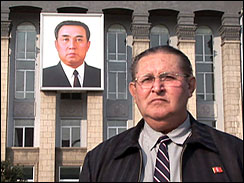Korea Times
Kim Rahn
1/30/2007
One-fifth of North Koreans who defected to South Korea have gotten swindled here, according to the Korean Institute of Criminal Justice Policy. The majority of the swindlers were other North Korean defectors.
The report released Tuesday was based on a survey of 214 defectors over 20 years old conducted between July and September.
According to the report, 50 of the 214 polled had been the victims of fraud, theft or burglary. The victims constituted 23.4 percent of the total. Only 4.3 percent of South Koreans report having been the victim of similar crimes.
Most of the defectors who reported the crimes were affected once, but one defector was the victim of eight crimes. The 50 who reported crimes were involved in 91 crimes. Of the 91, 46 involved fraud and 11 involved violence.
The percentage of the victims who fell prey to fraud was 21.5 percent. About 0.5 percent of the South Korean population has reported fraud.
Among the 46 fraud victims, 28.6 percent lost money through a business or investment, 26.6 percent lent money to others and were not paid back and 19 percent gave money to someone who said they would bring the defectors’ family in the North to South Korea and didn’t do so.
Most of the victims of business-related fraud lost money after investing in multi-level marketing companies. Those who invited the victims to the join the businesses were mainly other North Korean defectors, according to the report.
Six of the eight cases related to bringing relatives here from the North were committed by North Korean defectors.
Those with more education were more subject to fraud. Some 42 percent of defectors with college degrees and 14.1 percent of high school graduates were swindled, but none of those who had elementary school education was a victim of fraud.
Most of the surveyed defectors did not trust people, with 63.9 percent saying they should be wary of others in South Korean society.
“The government has to prepare counseling centers and give more detailed law education to North Korean defectors when they leave Hanawon, a state-run settlement facility for defectors,” a researcher said.
N. Korean defectors shift attitude to adapt to capitalism
Yonhap
1/11/2007
For a growing number of North Korean defectors to South Korea, the stark reality of capitalism might offset their long-held dream of living in a free, affluent country.
In a capitalistic society like South Korea, a measure of freedom and independence can come only with ability to compete for decent jobs and willingness to adapt to new circumstances.
“They have a sheer illusion that if they arrive in South Korea, the people will treat them well. But they get disillusioned soon, and their lives get devastated if they don’t try hard to adapt themselves,” said Kim Seung-chul, a researcher at the Institute of North Korea Studies.
The total number of North Korean defectors will likely top 10,000 sometime this year, according to government officials.
So far, 9,265 North Koreans have settled down in the South after finishing all the procedures and obtaining social security numbers, while some 400 are receiving adaptive education at a state-run institute. More than 500 defectors are currently under the custody of South Korean embassies or consulates in Thailand, Mongolia and other countries.
“This year, a lot more North Koreans will likely escape and attempt to come to the South because the food situation is expected to worsen following the missile and nuclear device tests,” said a senior official at a Seoul-based aid group for the defectors on condition of anonymity.
Since heavy floods hit the North in the mid-1990s, the annual number of North Korean defectors reached double digits and in 1999 it swelled to a triple-digit level. In 2002, as many as 1,139 defectors arrived in the South, a sharp rise from 583 the previous year, government data showed.
“In the past, we provided direct help, or unilaterally protective aid, but the policy is shifting to an indirect one aimed at helping them stand on their own. The government will provide more job training and employment opportunities,” a Unification Ministry official said, asking to remain anonymous.
Since 2005, South Korea has introduced an incentive system for North Korean defectors on the basis of their performance in job training and the level of adaptation, aside from the money provided to help them settle in the South.
But the prevailing sentiment among the defectors is that they cannot survive in the South only with government subsidies or state-offered jobs.
“What matters is attitude. They should make efforts to understand the South Korean society and prepare themselves for competition,” said Kim Young-hee, 43, president of an aid group for North Korean defectors.
Park Cheol-yong, 32, who fled the North and arrived here in 2002, had difficulties adapting to the different work culture, but he decided to soldier on, believing that he would have a chance to get recognition after years of experience.
“The cultural differences are far greater than expected, but I tried hard to overcome the problem by adjusting to new circumstances,” said Park, who works at a stationery company.
Park, who is married with a three-year-old son, graded himself “mediocre” in the level of adaptation and expressed hope that life will get much better here as time goes by.
“Life will be much more difficult if I quit the job so easily because of the stress I get from work now. I will do my best to succeed,” said Park, who works for the sales of stationery in the morning and delivers stationery in the afternoon.

 The folks who brought us “
The folks who brought us “ In the 1960s four US soldiers separately defected to North Korea, and were little heard from again.
In the 1960s four US soldiers separately defected to North Korea, and were little heard from again.